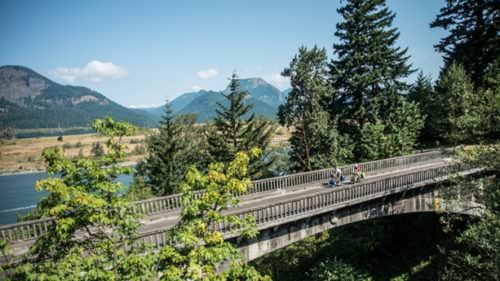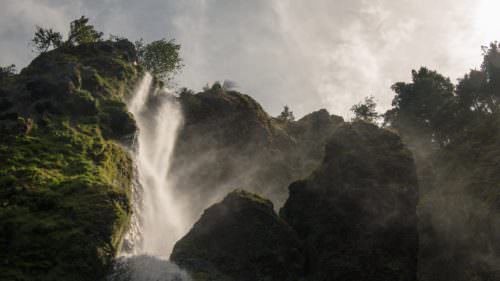The Columbia River Gorge was designated a National Scenic Area — the largest in America — for good reason.
You’d be hard-pressed to find vistas as stunning as these. At the western end of the Gorge, the view from Crown Point is a front-row seat to the mighty Columbia as its unfurls and cuts through the Cascade mountains. From there dozens of awe-inspiring waterfalls spill from basalt cliffs, lining the Historic Columbia River Highway, like the famous Multnomah, Bridal Veil and Latourell falls. The landscape seems to grow bigger, grander and brighter as it rolls east.
Bring your sense of adventure because the Gorge is made for exploring. Walk along a waterfront, discover hidden waterfalls, follow the wildflowers at Rowena Crest or challenge yourself with a trek up the Angel’s Rest Trail. Cycle the roads around The Dalles or in the Post Canyon mountain bike network. And it’s hard to resist water sports on the Columbia, especially when Hood River is known as the windsurfing capital of the world.
But the Columbia River Gorge isn’t just spectacular scenery. There’s plenty of farm-fresh dining and estate-grown cider, too. Thanks to its unique geography, the Gorge boasts a world of wine too — from pinot noir and chardonnay in the cool western hills, to tempranillo and syrah in the drier, sunnier east.
Top Tips for Visiting the Gorge
- How many days do you need to visit the Columbia River Gorge?
You can easily spend an entire day at one attraction, waterfall or trail in the Gorge. Depending on how much time you have, it would be best to devote several days to the region to get the most out of the magnificent outdoors, cultural sites and food and drink culture.
- What is the best way to see the Columbia River Gorge?
There’s no one right way — choose whatever works for your budget and style. To see the Gorge by car you can use the Hood River Fruit Loop, the Infinity Loop, the West Gorge Food Trail or the East Gorge Food Trails as blueprints and inspiration. You can also see it by bus or shuttle, to avoid traffic, parking hassles and permit fees at Multnomah Falls during summer season. It’s great to experience the Gorge by bike or e-bike — either bring your own, rent one at a local shop or book a guided bike tour. See it the Gorge by water by booking a Portland Spirit cruise or a paddle or kiteboarding lesson. Or see it by air on a helicopter tour with Envi Adventures.
- Is the Columbia River Gorge worth it?
The Gorge is frequently ranked as a top destination in the U.S. and world. The Mt. Hood and Columbia River Gorge region was ranked as one of the 10 best regions in the world by Lonely Planet. National Geographic ranked the Gorge as No. 2 in the U.S. and No. 10 internationally. U.S. News & World Report included the Gorge as one of the best places to visit in Oregon.
- What town is near the Columbia River Gorge?
The top towns in the Gorge are Hood River — known as the windsurfing capital of the U.S. — and The Dalles, known for its dry, sunny climate and average of 300 days of sunshine per year. The towns of Cascade Locks and Mosier are also top spots to enjoy nearby Hood River.
- Do you need a reservation for the Columbia River Gorge?
Multnomah Falls, the most popular visitor attraction in the Gorge, requires a timed-use permit to visit during peak season, late May through early September. You can book a shuttle, bike tour or public transit trip to avoid the permit requirement. You can also visit during spring or fall, which are both lovely times of year, and much less crowded.
- How long does it take to drive through the Gorge?
The Infinity Loop, a figure eight-shaped loop, is a great way to experience top sights between Troutdale, Cascade Locks, Hood River, Mosier, The Dalles, Dufur, Government Camp and Estacada. Depending on how much activity you take on and how many stops you pack in, you can enjoy the loop in several hours or one day, or make it a multi-day excursion.
- What should I wear to visit the Columbia River Gorge?
The Gorge is generally mild year-round, but can get very hot in summer and can snow and be impacted by ice in winter. It can also rain any time of year, so it’s best to be prepared for all conditions when you visit. Sunscreen, hats, sunglasses, sturdy shoes and layers are best, along with your Ten Essentials for hiking.


